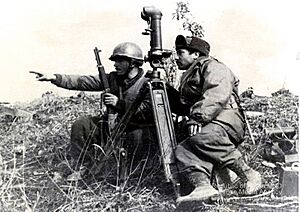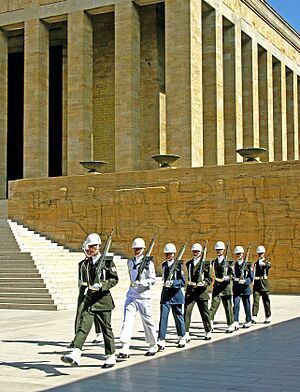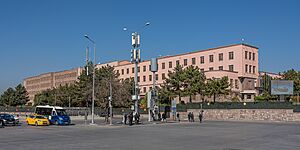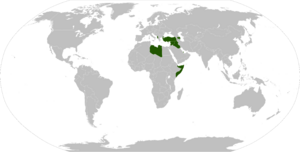Turkish Armed Forces facts for kids
Quick facts for kids Turkish Armed ForcesTürk Silahlı Kuvvetleri (Turkish) |
|
|---|---|
|
Emblem of the Turkish Armed Forces |
|
| Established | 3 May 1920 |
| Parts | |
| Headquarters | General Staff Building, Bakanlıklar, Çankaya, Ankara, Turkey |
| Leadership | |
| Commander-in-Chief | |
| Chief of the General Staff | |
| Serving soldiers | |
| Military age | 20 |
| Conscription | 1/6/12 months (rank dependent) |
| Active employees/soldiers | 425,200 |
| Reserve personnel | 380,700 |
| Expenditures | |
| Budget | US$15.8 billion (2023) |
| Percent of GDP | 1.5% (2023) |
| Industry | |
| Suppliers from inland |
List
SSB |
| Suppliers from foreign countries |
|
| Annual exports | $5.5 billion (2023) |
| See also | |
| History |
|
| Ranks | Military ranks of Turkey |
The Turkish Armed Forces (TAF), also known as the Türk Silahlı Kuvvetleri (TSK) in Turkish, are the military forces of Turkey. They protect the country and its people. The TAF is made up of three main parts: the Land Forces, the Naval Forces, and the Air Forces.
The Chief of the General Staff leads the entire Armed Forces. During wartime, this Chief acts as the Commander-in-Chief for the President. The President represents the highest military command. The General Staff also helps Turkey work with other NATO countries and friendly nations.
The Turkish Armed Forces began after the collapse of the Ottoman Empire. They saw themselves as protectors of Kemalism, which is Turkey's official way of thinking, especially its focus on keeping government separate from religion. Turkey joined NATO in 1952. After that, they started a big plan to make their military modern. The Turkish Army even sent 14,936 soldiers to fight in the Korean War alongside South Korea and NATO.
The Turkish Armed Forces are the second largest military in NATO. Only the U.S. Armed Forces are bigger. Turkey is also one of five NATO countries that share nuclear weapons. This means they host some nuclear bombs from the U.S. at the Incirlik Air Base.
Contents
History of the Turkish Armed Forces
Forming the Military: War of Independence
The Turkish War of Independence happened from 1919 to 1923. It was a series of fights by the Turkish National Movement. This happened after parts of the Ottoman Empire were taken over by other countries. This was after the Ottoman Empire lost World War I.
The Turkish National Movement fought against Greece, Armenia, and France. They also fought against some local groups and British and Ottoman troops. On May 3, 1920, the first Minister of National Defence was appointed. This was for the new government called the government of the Grand National Assembly (GNA).
The Allies, who won World War I, wanted to control Anatolia. So, they encouraged Greece to send troops to Smyrna (İzmir). This started the War of Independence. A new nationalist government, led by Mustafa Kemal, was set up in Ankara. This government did not agree with the old Ottoman government.
During the war, local fighters defeated French forces. They also worked with Russian forces to divide Armenia. The main fighting was against Greece. At first, the Greek army faced unorganized resistance. But then, the Turkish forces became a regular army. They fought the Greeks in important battles like the First Battle of İnönü and Second Battle of İnönü.
The Turks stopped the Greek advance in the Battle of Sakarya. Then, they launched a big attack called the Great Offensive. This pushed Greek forces out of Anatolia in just three weeks. The war ended when the Turks captured Smyrna.
In July 1923, the Treaty of Lausanne was signed. This recognized the Grand National Assembly in Ankara as the real government of Turkey. The Allies left Anatolia. The Ottoman government was removed, and the monarchy ended. On October 29, 1923, the Republic of Turkey was declared. This marked the end of the Ottoman era. Turkey became a modern, secular country.
World War II and Neutrality
Turkey stayed neutral for most of World War II. At the start, Turkey signed a treaty to help Great Britain and France. But after France fell, Turkey tried to stay friendly with both sides. These were the Allies and the Axis.
After Nazi Germany took over the Balkans, German-controlled areas bordered Turkey. So, Turkey signed a friendship agreement with Germany in 1941. Later, after Germany retreated from the Caucasus, Turkey moved closer to the Allies. Winston Churchill met with Turkish leader İsmet İnönü in 1943. They talked about Turkey joining the war.
Turkey finally joined the Allies on February 23, 1945. They declared war against Germany and Japan. This was because only countries formally at war by March 1, 1945, could join the United Nations.
Fighting in the Korean War

Turkey joined the Korean War as a member of the United Nations. They sent the Turkish Brigade to South Korea. Turkish soldiers showed great bravery in combat. Sadly, 731 Turkish soldiers lost their lives.
In 1952, Turkey became a member of NATO. South Korea built a memorial in Ankara for the Turkish soldiers who fought and died in Korea.
Cyprus Operations
On July 20, 1974, the TAF launched an operation on Cyprus. This was in response to a coup attempt on the island. The goal of the coup was to unite Cyprus with Greece. The Turkish military intervention led to Turkey occupying a part of northern Cyprus. This helped create a local government for Turkish Cypriots.
Before this, there had been years of fighting between Greek Cypriots and Turkish Cypriots. Turkey said it was acting as a guarantor under a treaty from 1960. Turkish forces landed in two waves. They took control of 37% of the island's northeast. This area became home to Turkish Cypriots, who had been living in small separate areas.
Afterward, the Turkish Cypriots declared their own state in 1975. In 1983, they declared independence as the Turkish Republic of Northern Cyprus. Only Turkey recognizes this state. The United Nations still sees the Republic of Cyprus as the only sovereign government for the whole island. This conflict still affects Turkey's relationships with Greece and the European Union.
Helping in Bosnia and Kosovo
Turkey sent troops to several NATO-led peacekeeping missions. These were in Bosnia and Kosovo. Today, there are still Turkish troops in the Kosovo Force.
Helping in Afghanistan
After the 2003 Istanbul Bombings, Turkey sent troops to Afghanistan. Their mission was to fight Taliban forces and Al-Qaeda. Turkey's role included keeping Kabul safe. They also trained Afghan security forces.
Turkey's troops were not involved in direct combat. Turkey resisted pressure to send more combat troops. Turkey withdrew its troops from Afghanistan after the fall of Kabul (2021).
Humanitarian Aid Missions
The TAF also helps with "Disaster Relief Operations." For example, they helped after the 1999 İzmit earthquake in Turkey. The Turkish Navy also works with other countries in the Black Sea Naval Co-operation Task Group. This group does search and rescue and other humanitarian missions in the Black Sea.
The Turkish Armed Forces Today
In 2023, the Turkish Armed Forces had about 890,500 people. Around 355,200 of these are active soldiers. This includes 260,200 in the Land Forces, 45,000 in the Naval Forces, and 50,000 in the Air Force. There are also many reserve personnel and paramilitary forces.
Turkey aims to make its own military equipment. The goal is to become more independent in military technology. Turkish companies like HAVELSAN are working with companies like Boeing. They are developing advanced defense systems.
General Staff and Command
The Chief of the General Staff reports to the Minister of National Defence. The General Staff is in charge of several important tasks:
- Preparing the Armed Forces for military operations.
- Gathering important military information.
- Organizing and training the different parts of the Armed Forces.
- Managing all the supplies and support services.
The Chief of the General Staff also leads the Special Forces. These special units get their orders directly from the General Staff.
Land Forces: The Army
The Turkish Land Forces, or Turkish Army, started from the remaining Ottoman forces after World War I. When the Grand National Assembly was formed in 1920, they decided to create a regular army. This new army won the Turkish War of Independence in 1922.
The Turkish Naval Forces, or Turkish Navy, is the part of the military that operates at sea. The Turkish Navy has special units like Marines and Special Operations teams. The Amphibious Marines Brigade has 4,500 soldiers. They are trained for landings from the sea.
The Su Altı Taarruz (S.A.T. – Underwater Attack) unit gathers military information. They also do special attacks and protect important people. The Su Altı Savunma (S.A.S. – Underwater Defense) unit protects the coast. They clear mines and disable enemy ships underwater.
Air Force: Protecting the Skies
The Turkish Air Force protects Turkey's airspace. It also provides air support to the Army and Navy. Turkey is one of five NATO countries that are part of the nuclear sharing policy. This means they host some B61 nuclear bombs at the Incirlik Air Base.
The Air Force has taken part in NATO operations. These include missions in Bosnia-Herzegovina and Kosovo. They also participated in the Baltic Air Policing operation.
Turkish Military Bases Abroad
As of 2021, Turkey has over 60,000 military personnel stationed outside its borders. This means about 1 in 6 active Turkish soldiers are deployed abroad. The main permanent base is the Cyprus Turkish Peace Force Command in Northern Cyprus.
Turkey also has military bases and troops in several other countries:
- Albania: Around 24 troops at Pasha Liman Base.
- Azerbaijan: Troops and an observation base in the Nagorno-Karabakh region.
- Bosnia and Herzegovina: About 242 troops as part of a European Union operation.
- Iraq: Turkey has many military and intelligence bases in Iraq. They have between 5,000 and 10,000 soldiers there.
- Kosovo: Around 321 troops for a NATO peacekeeping force.
- Libya: Troops at several airbases.
- Northern Cyprus: Between 35,000 and 40,000 Turkish soldiers are on active duty here.
- Qatar: A military base in Doha with 5,000 personnel.
- Somalia: A base called Camp TURKSOM with 2,000 personnel.
- Syria: Many bases and observation points with an estimated 10,500 soldiers.
Turkey also has troops in UN peacekeeping missions in other countries:
- Central African Republic: 50 soldiers.
- Democratic Republic of the Congo: 152 units.
- Lebanon: 100 personnel.
- Mali: 50 soldiers.
The Military's Role in Turkish Politics
After Turkey became a republic in 1923, Mustafa Kemal Atatürk made rules to keep military officers out of politics. However, after a military takeover in 1960, a new law was made. This law allowed the military to get involved in politics.
The Turkish military saw itself as the protector of Kemalism. This is Turkey's official way of thinking, especially its focus on keeping government and religion separate. The military still has some influence on national security decisions. This happens through the National Security Council.
The military has stepped into politics several times in the past. They removed elected governments four times. They took power in 1960, 1971, and 1980. In 1961, after the 1960 takeover, the military executed the first democratically elected prime minister. In 1997, they helped remove an Islamist prime minister. Many Turkish people sometimes welcomed these actions. They felt the governments were not following the constitution.
In 2007, the army made a statement. They warned that they were ready to act if Turkey's secular nature was threatened. This was before a presidential election.
In 2016, a group within the Turkish Armed Forces tried to take over the government. However, supporters of President Erdogan and other loyal military units stopped the attempt. The parliament building and police headquarters were damaged. Hundreds of civilians died, and thousands were injured. After this failed attempt, many military personnel were arrested. The structure of the armed forces was changed.
Medals and Awards
The Turkish Armed Forces give out several medals for bravery and service:
- Turkish Armed Forces Medal of Honor
- Turkish Armed Forces Medal of Distinguished Service
- Turkish Armed Forces Medal of Distinguished Courage and Self-Sacrifice
- Turkish Armed Forces Medal of Bravery and Valour
- Turkish Armed Forces State Medal of Honor
Images for kids
See also
- Conscription in Turkey
- Military equipment of Turkey
- Gendarmerie General Command (Turkey)
- Coast Guard Command (Turkey)
- Village guard system
- Defense industry of Turkey
- List of countries by military expenditures
- List of countries by number of military and paramilitary personnel
- List of active Turkish Air Force aircraft


















